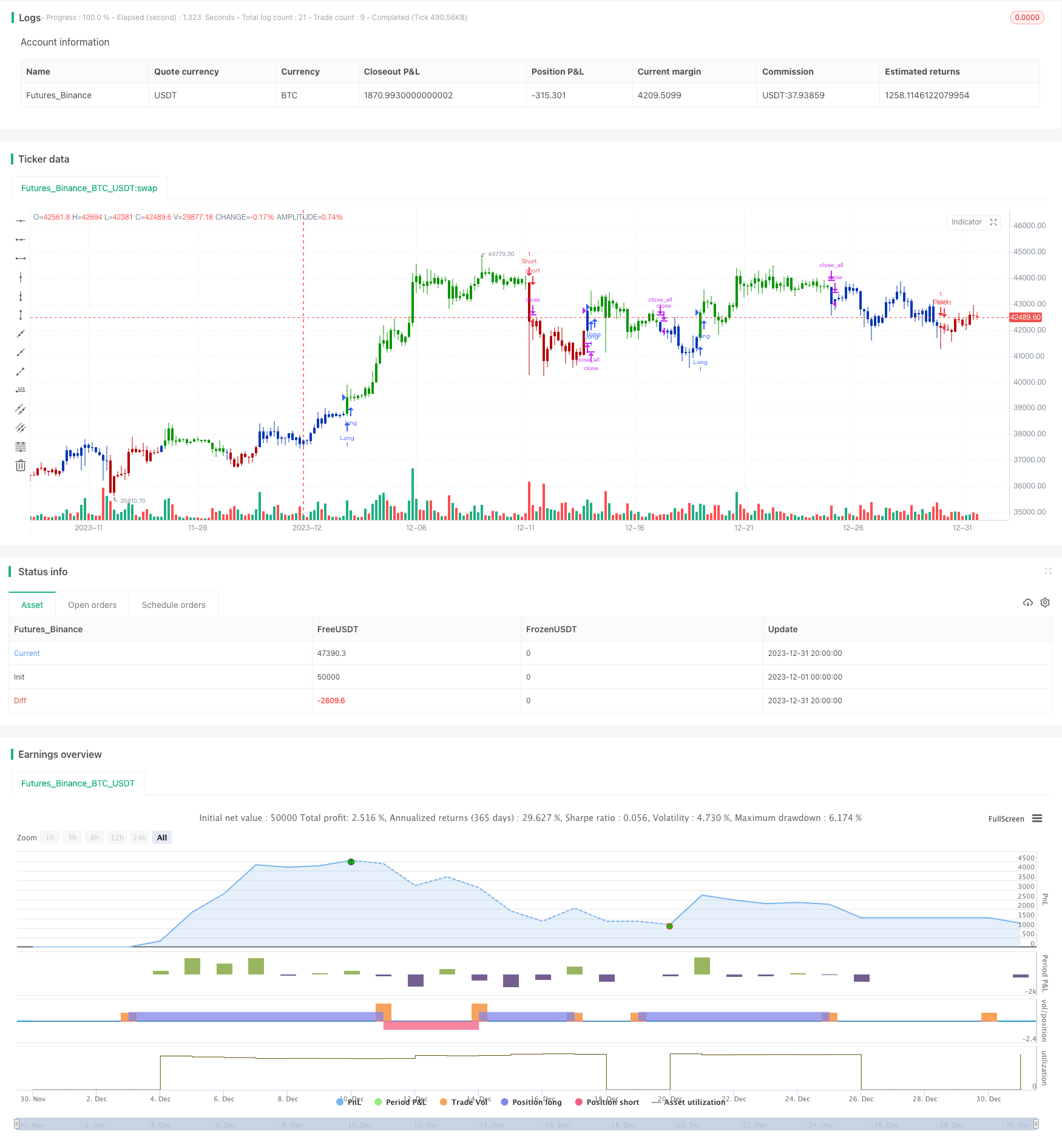Estrategia de doble media móvil combinada con el indicador estocástico
El autor:¿ Qué pasa?, Fecha: 2024-01-12 11:16:52Las etiquetas:

Resumen general
Este artículo presenta una estrategia de negociación cuantitativa que combina la doble estrategia de promedio móvil y el indicador estocástico.
Principio de la estrategia
La estrategia consta de dos partes:
-
Estrategia de media móvil doble
Utilizando promedios móviles rápidos y lentos para generar señales de compra cruz dorada y señales de venta cruz muerta.
-
Indicador estocástico
Utilizando la característica de oscilación del estocástico para identificar situaciones de sobrecompra y sobreventa. Un estocástico superior a la línea lenta indica una señal de sobrecompra, mientras que un estocástico inferior a la línea lenta indica una señal de sobreventa.
Las señales de ambas partes se combinan para formar las señales finales de negociación.
Análisis de ventajas
- Combina las ventajas de las medias móviles duales y estocásticas, más estables.
- Los promedios móviles para seguir la tendencia, los estocásticos para confirmar, buen efecto.
- Los parámetros personalizables se adaptan a las diferentes condiciones del mercado.
Análisis de riesgos
- Las medias móviles dobles pueden generar fácilmente señales falsas.
- Las configuraciones incorrectas de los parámetros estocásticos pueden perder las tendencias.
- Necesidad de ajustar los parámetros para adaptarse a los cambios del mercado.
Los riesgos pueden reducirse optimizando las combinaciones de parámetros y añadiendo stop loss a las pérdidas de control.
Direcciones de optimización
La estrategia se puede optimizar en los siguientes aspectos:
- Prueba los efectos de los diferentes parámetros de la media móvil en la estrategia.
- Prueba los efectos de diferentes parámetros estocásticos en la estabilidad de la estrategia.
- Añadir indicadores de filtro de tendencia para mejorar la tasa de ganancia.
- Construir un mecanismo dinámico para controlar las pérdidas.
Resumen de las actividades
Esta estrategia combina las ventajas de las medias móviles duales y estocásticas. Mientras se sigue la tendencia principal del mercado, se evitan inversiones desfavorables. Se pueden obtener mejores resultados de la estrategia a través de la optimización de parámetros.
/*backtest
start: 2023-12-01 00:00:00
end: 2023-12-31 23:59:59
period: 4h
basePeriod: 15m
exchanges: [{"eid":"Futures_Binance","currency":"BTC_USDT"}]
*/
//@version=4
////////////////////////////////////////////////////////////
// Copyright by HPotter v1.0 24/11/2020
// This is combo strategies for get a cumulative signal.
//
// First strategy
// This System was created from the Book "How I Tripled My Money In The
// Futures Market" by Ulf Jensen, Page 183. This is reverse type of strategies.
// The strategy buys at market, if close price is higher than the previous close
// during 2 days and the meaning of 9-days Stochastic Slow Oscillator is lower than 50.
// The strategy sells at market, if close price is lower than the previous close price
// during 2 days and the meaning of 9-days Stochastic Fast Oscillator is higher than 50.
//
// Second strategy
// As the name suggests, High low bands are two bands surrounding the underlying’s
// price. These bands are generated from the triangular moving averages calculated
// from the underlying’s price. The triangular moving average is, in turn, shifted
// up and down by a fixed percentage. The bands, thus formed, are termed as High
// low bands. The main theme and concept of High low bands is based upon the triangular
// moving average.
//
// WARNING:
// - For purpose educate only
// - This script to change bars colors.
////////////////////////////////////////////////////////////
Reversal123(Length, KSmoothing, DLength, Level) =>
vFast = sma(stoch(close, high, low, Length), KSmoothing)
vSlow = sma(vFast, DLength)
pos = 0.0
pos := iff(close[2] < close[1] and close > close[1] and vFast < vSlow and vFast > Level, 1,
iff(close[2] > close[1] and close < close[1] and vFast > vSlow and vFast < Level, -1, nz(pos[1], 0)))
pos
HLB(Length, PercentShift) =>
pos = 0.0
xTMA = sma(sma(close, Length), Length)
xHighBand = xTMA + (xTMA * PercentShift / 100)
xLowBand = xTMA - (xTMA * PercentShift / 100)
pos :=iff(close > xHighBand, 1,
iff(close <xLowBand, -1, nz(pos[1], 0)))
pos
strategy(title="Combo Backtest 123 Reversal & High Low Bands", shorttitle="Combo", overlay = true)
Length = input(14, minval=1)
KSmoothing = input(1, minval=1)
DLength = input(3, minval=1)
Level = input(50, minval=1)
//-------------------------
Length_HLB = input(14, minval=1)
PercentShift = input(1, minval = 0.01, step = 0.01)
reverse = input(false, title="Trade reverse")
posReversal123 = Reversal123(Length, KSmoothing, DLength, Level)
posHLB = HLB(Length_HLB, PercentShift)
pos = iff(posReversal123 == 1 and posHLB == 1 , 1,
iff(posReversal123 == -1 and posHLB == -1, -1, 0))
possig = iff(reverse and pos == 1, -1,
iff(reverse and pos == -1 , 1, pos))
if (possig == 1)
strategy.entry("Long", strategy.long)
if (possig == -1)
strategy.entry("Short", strategy.short)
if (possig == 0)
strategy.close_all()
barcolor(possig == -1 ? #b50404: possig == 1 ? #079605 : #0536b3 )
- Estrategia de negociación de inversión de la relación volumen
- Estrategia de cruce de la media móvil ponderada por impulso dinámico
- Estrategia de negociación de poder alcista
- Estrategia de seguimiento de la media móvil diaria para el valor del oro
- Promedio móvil de varios plazos combinado con las horas de negociación Estrategia cuantitativa de negociación
- Estrategia de negociación de varios plazos basada en el MACD
- Estrategia de seguimiento de la potencia del oso
- Tendencia de la estrategia de negociación basada en múltiples indicadores
- Estrategia de negociación de fluctuación con cruce de la EMA 20/50
- Estrategia optimizada de seguimiento de tendencias dinámicas
- Estrategia de seguimiento de tendencias basada en la media móvil y el rango verdadero de la media
- Estrategia de tendencia cuantitativa basada en múltiples factores
- Estrategia de negociación basada en derivados
- Estrategia de MACD sólo larga
- Estrategia de tendencia cruzada de la media móvil
- Estrategia de negociación cuantitativa basada en el intercambio de SMA
- Estrategia de pérdida de pérdidas traseras
- Estrategia de soporte y resistencia con ruptura de volumen y pérdida de parada de seguimiento
- Movimiento de la estrategia de stop loss basada en puntos de tomar ganancias y stop loss
- Porcentaje de estrategia de pérdidas de parada de seguimiento